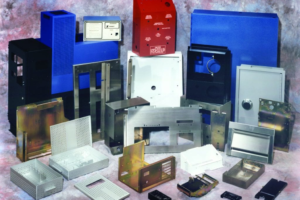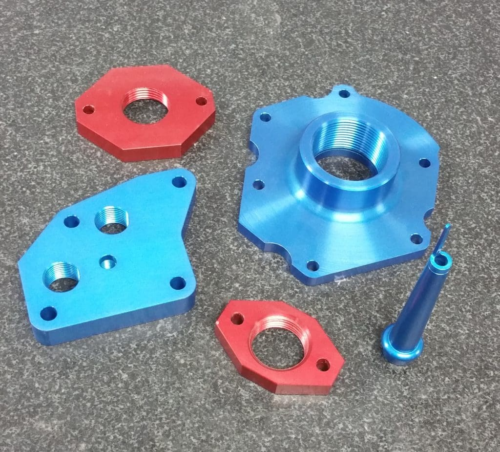A Guide to Sheet Metal Fabrication
Comments Off on A Guide to Sheet Metal Fabrication Sheet metal fabrication is the process of turning sheet metal into functional parts using a variety of different processes. Because of the customizability, durability, and cost-effectiveness of fabricated parts, sheet metal fabrication is essential to nearly every industry.
Sheet metal fabrication is the process of turning sheet metal into functional parts using a variety of different processes. Because of the customizability, durability, and cost-effectiveness of fabricated parts, sheet metal fabrication is essential to nearly every industry.
Lansco Manufacturing has fabricated high-quality sheet metal parts since 1986. From small precision components to complete factory automation, we have the experience to produce fabricated metal parts that suit your needs. We can assist you through the design, prototyping and production phases of your projects.
What Is Sheet Metal Fabrication?
Sheet metal fabrication encompasses many different methods of transforming sheet metal into usable metal components. Different types of metal can be used in the process to meet your needs. Some common sheet metals used include steel, stainless steel, aluminum, bronze, and copper, all with their own unique benefits.
Sheet Metal Fabrication Techniques
Common sheet metal fabrication techniques include:
- Cutting. Cutting is the initial operation in sheet metal fabrication. It can be done using a variety of methods including shearing, flame, plasma, laser and water jet cutting.
- Punching. During the punching process, sheet metal is placed between a die and a punch. The punch forces through the metal until it hits the die to create holes in the material.
- Stamping. Stamping is a cold-forming method that uses a punch, die, and shear pressure to turn flat metal blanks into various shapes.
- Forming. Sheet metal forming involves stretching sheet metal into a new shape rather than removing any material.
- Welding. Welding uses a combination of heat and pressure to join two or more pieces together into a single part.
- Bending. Bending is a sheet metal fabrication process that uses press brakes, rolling machines, and other equipment to bend sheets of metal.
- Deburring and Polishing. Removing burrs and sharp edges is critical for sheet metal components. Graining and polishing is often required to produce the desired appearance.
- Painting and Powder Coating. Custom finishes provide aesthetic and protective coatings for steel components.
Benefits of Custom Sheet Metal Fabrication
Sheet metal fabrication offers many benefits that make it popular across a range of industries and applications. Benefits include:
- Easy to transport. Sheet metal is light and has a low weight and gauge, making it easy to transport, handle, and install.
- Cost-effective. Sheet metal fabrication offers an affordable and efficient way to produce lightweight and high-quality products with little or no tooling investment.
- Has a wide variety of applications. Since fabricated sheet metal parts can be designed and produced to your specifications, you can create the exact parts you need using the appropriate metal materials.
- Accurate and durable. When combined with modern CNC technology, sheet metal fabrication can be extremely accurate. Sheet metal fabrication also offers parts with durable surfaces that can withstand a variety of environmental conditions.
- Allows for the salvaging of old equipment. If an old part is no longer being produced, instead of replacing the entire machine, you can get a new part custom-fabricated. Engineers can reverse engineer old parts and save you money in equipment replacement.
Applications and Industries
Sheet metal fabrication is essential to almost every industry because of its versatility and strength. Here are some major industries that rely on sheet metal fabrication:
- Aerospace. Sheet metal fabrication is used to produce parts and components for commercial aircraft, military aircraft, and spacecraft as well as ground support equipment.
- Energy. Sheet metal fabrication is used to create various components for the energy sector, including wind turbines, pipelines, transmission towers, and more.
- Mining. Mining operations rely on machinery and tools that are often created using sheet metal fabrication. Shovels, trucks, dragline excavators, and more rely on fabricated sheet metal parts.
- Architecture and construction. Sheet metal fabrication produces beams, supports, and sheets in the correct dimensions for various construction and architecture projects.
- Medical and Pharmaceutical. Medical instruments and equipment such as MRI machines, medical imaging equipment, and ultrasound machines rely on fabricated sheet metal parts. Sheet metal fabrication is especially useful in the medical industry where precision and durability are paramount.
- Food Processing and Packaging. Equipment such as slicers, grinders, washers, fillers, cappers, seamers, labelers, wrappers, and conveyors all use stainless sheet metal requiring sanitary grade welding and finishing.
- Transportation. Cars, trains, and other vehicles are made of many fabricated metal parts. For example, car frames use durable fabricated metal parts that are sturdy enough to support the weight of the car.
- Shipbuilding. Many ships require ladders, steel hulls, metal stairs, and other metal parts. This equipment is all produced with sheet metal fabrication.
Custom Sheet Metal Fabrication at Lansco Manufacturing
At Lansco Manufacturing, we offer custom sheet metal fabrication services to meet the needs of various industries. Sheet metal fabrication is essential to many businesses, and with our years of experience, we can help you design and produce the parts you need while saving you time and money. We can fabricate parts of virtually all sizes and quantities quickly and cost effectively. Contact us today or request a quote to get started on your custom sheet metal fabrication solution.
What Is Precision Machining?
Comments Off on What Is Precision Machining?The term “precision machining” describes many processes capable of producing highly accurate and precise components using computer numerical control (CNC) technology. Precision machining turns raw materials into precise components using a digital computer-aided design (CAD) file. This file is read by CNC equipment that uses it to carry out the manufacturing process. Compared to standard CNC machining, which can typically meet tolerances of 0.008’’ or 0.005’’, precision machining can achieve tolerances of 0.001’’ or better.
Types of Precision Machining
There are many CNC machining processes that can be used to create highly precise components. Some of the most widely used types of precision machining include:
- CNC Turning. CNC turning machines are available in 3, 4, and 5-axis varieties and work by rotating the raw material while tools remove portions to create the desired shape. The tooling is mounted on a turret that is computer-controlled.
- CNC Milling. Milling machines are available in 2 to 5-axes and cut along different angles. There are several types of differently oriented CNC milling machines, but all types perform subtractive processes to transform raw material into a precise component.
- CNC Swiss Turning. CNC Swiss turning produces extremely small parts accurately and quickly. In this process, only the portion of the material being machined enters the tooling area while the remainder is held securely for maximum precision. The workpiece moves along a Z-axis while turning as tools cut into the material.
- CNC Vertical. Vertical lathes feature vertically-oriented spindles and move the workpiece up or down to align it with the tools. This equipment is best suited for components that focus on a single side, such as a large metal plate.
- CNC Horizontal. Horizontal lathes use a variety of heads mounted onto a horizontal arbor. They work well with a wide variety of workpiece shapes and sizes. Most horizontal lathes can accommodate automatic bar-stock feeders.
Precision Machining Benefits and Applications
There are many benefits to choosing precision machining processes. For example, precision machining delivers significant cost savings over other production methods. Since it is highly precise, it produces less waste and optimizes material usage. Additionally, the computer-controlled process eliminates the risk of human error.
Another significant benefit of precision machining is that its efficiency allows for the production of highly repeatable parts at fast speeds. Since these processes require such little human involvement, it is much safer than other manual manufacturing techniques.

The applications for precision machined components span many industries. For example, the aerospace and medical industries both require machined components to be as precise as possible, as human lives are at risk by even the smallest inaccuracy. The automotive and electronics industries also rely on precision machining techniques.
Materials Used in Precision Machining
A wide selection of materials can undergo precision machining processes. Some of the most commonly used substrates include:
- Aluminum. This material features many benefits, including cost-effectiveness, corrosion resistance, and lightweight.
- Brass. Brass is easily machinable and economical.
- Bronze. Bronze offers excellent heat and electrical conductivity.
- Copper. This material is ideal in applications requiring electrical conductivity.
- Carbon steel. Carbon steel is highly durable and strong.
- Plastic. Plastic offers an inexpensive and non-conductive option.
- Titanium. This material features an excellent strength-to-weight ratio as well as high heat and corrosion resistance.
- Stainless Steel. Stainless steel is sought after for its durability and high strength-to-weight ratio as well – this makes it possible to machine thinner materials.
- Tool Steels. Customers looking for parts that feature abrasion, wear, and deformation resistance will find tool steels (which are typically compositions of carbon and alloy steels) to be a great choice.
CNC Precision Machining at Lansco Manufacturing
There are many benefits to choosing precision machining processes, especially when manufacturing complex components that require a high degree of accuracy. Since there are so many types of precision machining available, these processes can meet the needs of nearly any application or industry.
Lansco Manufacturing has been providing accurately machined precision components for over 35 years. Our services range from prototyping to large production runs and include a wide selection of value-added services. To learn more about our precision machining capabilities, contact us or request a quote today.
